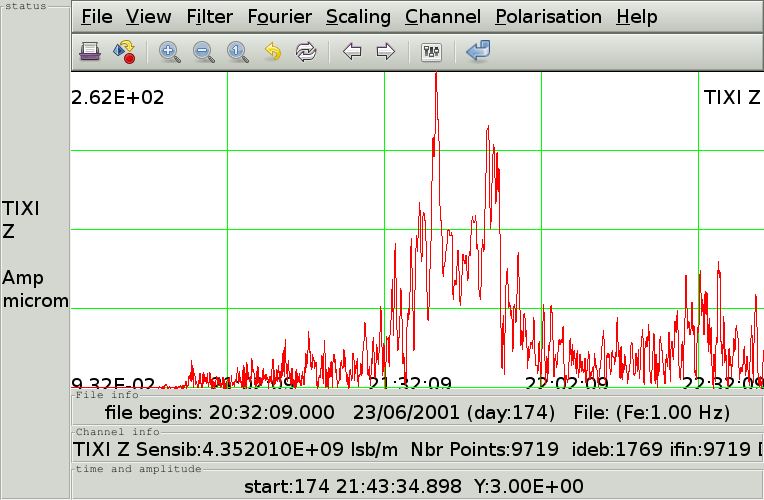Last Updated on August 27, 2023
Seismic Toolkit (STK) is an open source tool for seismic signal processing in a graphical interface.
It reads seismic signals in SAC format, and provides a variety of signal processing, such as filtering, spectral analysis, polarisation analysis, time-frequency representation, Hilbert transform, and singular value decomposition.
Some utilities are included for useful seismological applications, such as computation of Seismic Moment Mo, Mantle magnitude Mm and Moment magnitude Mw, MTPA spectral analysis, plotting focal mechanisms, computation (and plotting) of instrumental response from poles and zeros, and some usefull GMT (Generic Mapping Tool) scripts for plotting signals, responses, and time-frequency in Postscript files for high quality prints.
Features include:
- Powerful Data Handling – The Seismic Toolkit accesses its data through a published data interface.
- Trace display type – INT new fast rasterizer engine supports the following display types: wiggle, variable area, variable density, interpolated density, color filled modes, or combinations.
- Built-in Processing Functions supporting a flexible trace processing pipeline to handle processes such as trace scaling, interpolation, filtering or Automatic Gain Control. Each process module is an object that can be individually controlled. Applications can replace any default module with their own.
- Conversion of segy file trace header coordinates from one datum to another datum and/or from one UTM zone to another onespan.
- Segy header viewer and editor.
- Over 200 datums and seven different projections supported.
- Graphic Overlays – overlay any number of seismic datasets, display interpretation or annotation data, and overlay logs or contours using the WellLog or the Contour toolkits.
- Local Trace Manipulation – Each trace can be positioned independently. User has control of trace highlight, polarity, visibility, color on a trace-by-trace basis. Fast local trace update.
- Virtual Scrolling – offers fast display of large sections with unlimited zooming in on a dataset. An image mode pre-rasterizes the data into an image buffer for faster scrolling or for using into movie loops.
- Orientation – support for drawing seismic traces from left to right, right to left, bottom to top or top to bottom.
- Editing – Editor panels are provided to edit the attributes of a section, including setting the display type, controlling the scaling of the data, setting the range of the data, or setting the interpolation mode. A color editor is available to dynamically update the colormap.
- Hardcopy Output – EPS is standard and CGM+ is a fully supported option.
- Qt Integration.
Website: seismic-toolkit.sourceforge.net (site down?)
Support:
Developer: Dominique Reymond
License: GNU GPL v2

| Popular series | |
|---|---|
| The largest compilation of the best free and open source software in the universe. Each article is supplied with a legendary ratings chart helping you to make informed decisions. | |
| Hundreds of in-depth reviews offering our unbiased and expert opinion on software. We offer helpful and impartial information. | |
| The Big List of Active Linux Distros is a large compilation of actively developed Linux distributions. | |
| Replace proprietary software with open source alternatives: Google, Microsoft, Apple, Adobe, IBM, Autodesk, Oracle, Atlassian, Corel, Cisco, Intuit, SAS, Progress, Salesforce, and Citrix | |
| Awesome Free Linux Games Tools showcases a series of tools that making gaming on Linux a more pleasurable experience. This is a new series. | |
| Machine Learning explores practical applications of machine learning and deep learning from a Linux perspective. We've written reviews of more than 40 self-hosted apps. All are free and open source. | |
| New to Linux? Read our Linux for Starters series. We start right at the basics and teach you everything you need to know to get started with Linux. | |
| Alternatives to popular CLI tools showcases essential tools that are modern replacements for core Linux utilities. | |
| Essential Linux system tools focuses on small, indispensable utilities, useful for system administrators as well as regular users. | |
| Linux utilities to maximise your productivity. Small, indispensable tools, useful for anyone running a Linux machine. | |
| Surveys popular streaming services from a Linux perspective: Amazon Music Unlimited, Myuzi, Spotify, Deezer, Tidal. | |
| Saving Money with Linux looks at how you can reduce your energy bills running Linux. | |
| Home computers became commonplace in the 1980s. Emulate home computers including the Commodore 64, Amiga, Atari ST, ZX81, Amstrad CPC, and ZX Spectrum. | |
| Now and Then examines how promising open source software fared over the years. It can be a bumpy ride. | |
| Linux at Home looks at a range of home activities where Linux can play its part, making the most of our time at home, keeping active and engaged. | |
| Linux Candy reveals the lighter side of Linux. Have some fun and escape from the daily drudgery. | |
| Getting Started with Docker helps you master Docker, a set of platform as a service products that delivers software in packages called containers. | |
| Best Free Android Apps. We showcase free Android apps that are definitely worth downloading. There's a strict eligibility criteria for inclusion in this series. | |
| These best free books accelerate your learning of every programming language. Learn a new language today! | |
| These free tutorials offer the perfect tonic to our free programming books series. | |
| Linux Around The World showcases usergroups that are relevant to Linux enthusiasts. Great ways to meet up with fellow enthusiasts. | |
| Stars and Stripes is an occasional series looking at the impact of Linux in the USA. | |